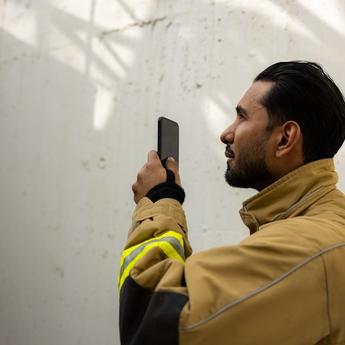TETRA over LTE? Public safety LTE? What do these things really mean?
Ask an engineer for the meaning of TETRA over LTE and they may say something like: "TETRA over LTE is an LTE smart device application and an interface in the TETRA service core to connect from the smart device to TETRA services, using a secured VPN tunnel over LTE data access."
Okay, but what does that mean in everyday terms?
Well, if you use a TETRA radio, adding TETRA over LTE will make it possible for you to talk to your smartphone-carrying colleagues in a group call. Just the same as anyone else. And the colleagues in the control room can manage these users and this communication, too.
Of course, making the connection is a little more complicated than that. Your smartphone-carrying colleagues will need Agnet, the special application that allows them to communicate in TETRA groups. The TETRA and LTE networks also have to work together in a certain way.
So, TETRA over LTE is a very practical way to gain important benefits by combining the use of two different technologies.

Is TETRA over LTE the same as public safety LTE?
Public safety LTE usually refers to the new public safety specific LTE standard features as defined by the 3GPP. The term public safety LTE also includes all kinds of solutions for public safety users. These range from whole radio network solutions to single function applications.
- A good example is a professional application designed for public safety, running on a LTE network. In this case, the LTE network may mean a commercial broadband network, or it may be a dedicated network, in the sole use of the public safety organization.
- Another example would be a complete system based on LTE, including important public safety features that adhere to the LTE standards. Certain crucial public safety features are already defined in the standards - some are under development and will be published in future releases.

TETRA vs LTE?
It should not be 'TETRA vs LTE' or 'TETRA or LTE' – a sudden switch to a completely new technology would be a huge risk to operations. Instead, think TETRA and LTE. A hybrid solution which combines the narrowband and broadband minimizes the risk of disruption. Current operational processes can be maintained while introducing new capabilities that complement the existing ones.
Complementing TETRA networks with broadband is the reliable way to evolve the network while minimizing the risks.
Many authorities and public safety organizations already use broadband as part of their communications. How can they make a success of introducing mission-critical broadband to public safety? Find out - download the executive briefing "How to minimize risks when introducing mission-critical broadband":
Could my organization use TETRA over LTE?
Adopting new apps and services would be difficult if they required a major revamp of processes and hardware. Instead, you need a solution which lets you continue to use your existing equipment and processes and use both both TETRA and LTE/4G/5G in a complementary way. The solutions must also be straightforward to implement.
The first smart step would be to have radios and smartphones communicating seamlessly in the same groups.
Take an example. You probably cooperate with many different organizations, and there are people who aren’t in constant contact – so carrying a radio would not be practical – but who need to communicate with your teams from time to time, in specific talk groups.

You may also have colleagues who do not carry a radio with them all the time. TETRA over LTE means that when their help and cooperation is needed, they can communicate with you in groups - using the Agnet app, for example.
----
Hand-picked content for you
When smartphone carrying professionals need the push-to-talk application to communicate in TETRA groups, the app needs to meet certain key requirements. Read the blog post "How to recognize a professional push-to-talk application" for more help.
----
If you adopt a professional app that can connect smartphone users to TETRA groups, you and your smartphone-carrying colleagues can communicate and work together. They can also communicate with the control room and from outside TETRA network coverage, provided the broadband network is available.
TETRA radio and a smartphone?
More and more professionals use both a TETRA radio and a smartphone to work. But what if the functions of a mission-critical radio and a smartphone could be combined? There is a solution. Tactilon Dabat is a rugged smartphone with a TETRA radio inside - and it is designed for ergonomic push-to-talk use.
Advanced applications are right at your fingertips, and in particular, the Agnet application can deliver an interesting benefit. With Agnet, Tactilon Dabat can automatically move from using the TETRA network to using an LTE broadband network or vice versa.
In other words, users are not restricted to stay within TETRA coverage. The user will be able to communicate as long as there is either TETRA or LTE network service available.

How secure is TETRA over LTE?
To make TETRA over LTE secure, we need to control who gets the application into their smartphones and which groups they can participate in and when.
A single tool is needed that lets you manage all users, both TETRA and smartphone. This will ensure that access to groups is controlled, allowing each user to communicate in the groups they need and removing access once the task is complete. Such a tool exists: several network operators use the Tactilon Management tool for managing just this.

There is another aspect of security that also needs to be considered. When public safety organizations get their broadband services directly from a commercial mobile network operator, it is difficult (or even impossible) for them to control where and how the user data is stored or processed.
A better way for public safety users is to choose a mission-critical Service Operator who will operate the mobile virtual network in an exceptionally secure way. This is regarded as the smartest step towards broadband and the solution with the lowest risk for public safety and security.
----
Hand-picked content for you
A Secure MVNO solution can ensure critical broadband security and offers additional layers of security to meet the needs of demanding professionals. Learn more from the white paper "Why Secure MVNO is your next smart move".
----
Four cornerstones
TETRA over LTE is more than just an application that brings TETRA communications to a smartphone. In fact, a comprehensive TETRA+LTE hybrid solution is based on the following four cornerstones:
- The application. Group calls in which radio users and smart device users can communicate easily can take teams to a completely new level of cooperation. Just make sure that your push-to-talk app has the required control and features that users need.
- Management of users and organizations. Efficient solutions are needed to manage radio users' data, access rights and other attributes, as well as a way to look after push-to-talk subscribers in the new hybrid world. A proper management tool can do all that.
- The user experience. Your users need uninterrupted communications services, but if the network is not your own or even your service operator's own, how can you be sure that it delivers as agreed? You or your service operator clearly need a solution for monitoring the level of service that users really get.
- The device. Users may need a new kind of device that works both as a TETRA radio and a smartphone. It may be practical to opt for a single device that can run professional apps, has the required design and form factors for prolonged use, and delivers TETRA radio capabilities.
In summary, TETRA over LTE is a practical way to gain important benefits by a hybrid solution that combines the use of both technologies.
Find out more about the exciting possibilities in the new, hybrid world: download the eBook "50 powerful reasons you will want to adopt hybrid solutions".
For a complete picture of hybrid solutions - not only TETRA and LTE - take a look at the Ultimate guide to hybrid solutions web page.
--- Editor's note: This post was originally published in October 2018 and has since been reviewed and updated for accuracy and comprehensiveness.






